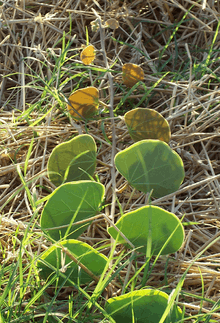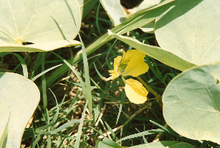Tylosema esculentum
| Tylosema esculentum | |
|---|---|
 | |
| Scientific classification | |
| Kingdom: | Plantae |
| (unranked): | Angiosperms |
| (unranked): | Eudicots |
| (unranked): | Rosids |
| Order: | Fabales |
| Family: | Fabaceae |
| Subfamily: | Caesalpinioideae |
| Tribe: | Cercideae |
| Genus: | Tylosema |
| Species: | T. esculentum |
| Binomial name | |
| Tylosema esculentum (Burch.) Schreiber | |
Tylosema esculentum, the Morama bean, is a long-lived perennial legume native to arid areas of southern Africa. Stems grow at least 3 metres, in a prostrate or trailing form, with forked tendrils that facilitate climbing. A raceme up to 25mm (1 inch) long, containing many yellow-orange flowers, ultimately produces an ovate to circular pod, with large brownish-black seeds.
Name
Also known as Morama; Camel's foot; Gemsbuck beans; tamani berry; morama bean; braaiboontjie (Afrikaans)
Form
Summer growth is typically prodigious, particularly in plants older than one year - due in part to its large underground tuber. The plant is dormant over winter in its native home - South Africa, Namibia and Botswana - but might possibly remain evergreen in less harsh environments.
The tuber can grow very large - at least 10 kg, perhaps much larger. In Botswana a tuber of 277 kg has been found.
The seeds develop in typical legume pods, albeit large and squat in shape - with typically one or two seeds per pod.



Uses
The plant is a significant food-source for the people of the Kalahari because of the high protein and oil content of its large seeds (20-30gm each). The seeds are usually roasted, imbuing them with a more palatable flavour - comparable to cashew or chestnut. The seeds can also be ground or boiled. The beans keep well, due to their hard outer shell.
The tuber is also edible, but needs to be harvested from young plants (one or two years old) - after this age the tuber becomes astringent and fibrous.
Propagation
The seed's hard outer shell means that scarification is necessary in order to ensure satisfactory germination rates.[1] As for most legumes, a pH neutral soil is preferred. The plant typically grows in very sandy loam, where waterlogging would not be a problem. Despite much global interest in this plant, propagation rates are still fairly low.
The plant can be grown outside, unsheltered, as far north as Zone 8 in the United States and perhaps further north; above ground growth is killed back by winter freezing, but the plant reemerges each Spring in late May. The greatest impediment to producing a crop of seeds is the long maturation time for the seed pods - which is right up to the first hard freeze of the year. Waterlogging is indeed an issue - leading to root rot - and a well drained sandy loam is preferred, but not essential.
Curiously, this and the other three members of the genus Tylosema are possibly unique within the family Fabaceae in the fact they exhibit heterostyly.[2] This reduces propagation potential, and obviously reduces seed production rates for cropping.
References
- ↑ Travlos, I. S.; Economou, G.; Karamanos, A. I. (2007). "Germination and emergence of the hard seed coated Tylosema esculentum (Burch) A. Schreib in response to different pre-sowing seed treatments". Journal of Arid Environments 68 (3): 501. doi:10.1016/j.jaridenv.2006.07.001.
- ↑ Hartley, M. L.; Tshamekeng, E.; Thomas, S. M. (2002). "Functional Heterostyly in Tylosema esculentum (Caesalpinioideae)". Annals of Botany 89 (1): 67–76. doi:10.1093/aob/mcf006. PMID 12096820.
External links
- Annals of Botany report on "Functional Heterostyly in Tylosema esculentum"
- Food and Agricultural Organisation of the United Nations
- Morama Engaged: Increasing community awareness and utilization of indigenous grains to improve nutrition security and livelihoods in Botswana and Namibia